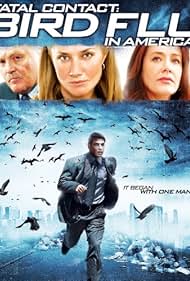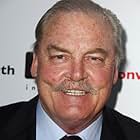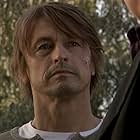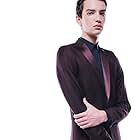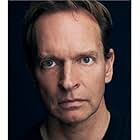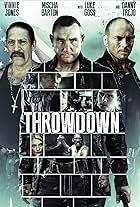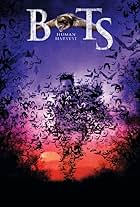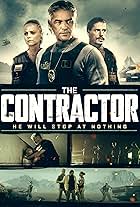An outbreak of avian flu mutates into a virus that becomes transmittable from human to human.An outbreak of avian flu mutates into a virus that becomes transmittable from human to human.An outbreak of avian flu mutates into a virus that becomes transmittable from human to human.
- Director
- Writer
- All cast & crew
- Production, box office & more at IMDbPro
Storyline
Did you know
- TriviaParallels the real life pandemic that occurs 15 years later in 2020.
- ConnectionsFeatured in The Cinema Snob: Fatal Contact: Bird Flu in America (2020)
Featured review
In Guangdong province, China, numerous birds infected with the H5N1 virus are being killed, but it may be too late to stop the disease from spreading. At least one man is sick at a nearby factory being visited by Ed Connelly of Richmond, Virginia, who is criticizing the factory's policies that are costing the company money (as far as we know, this has nothing to do with the disease).
As Connelly returns to the United States, we see extreme close-ups of the ways the disease is being spread by him to others on the plane. Soon after he gets back to Richmond, life appears normal but he is infecting others around him. He has no idea how sick he is.
Dr. Iris Varnack (Joely Richardson) is called to China, where 8 people have been infected by the bird flu virus. Correction--25 people. And the doctor there believes these cases, unlike others before, were passed from human to human rather than from bird to human. Dr. Varnack soon must inform the government that a pandemic worse than the 1918 Spanish Flu is a strong possibility. 300 million people could die worldwide (compared to 50 million in the earlier disaster).
Connelly becomes delusional and passes out in a store, and once doctors figure out what is wrong, all who visit him, including his wife Denise (Ann Cusack), must wear what look like space suits. By the first commercial break, the death toll is 125.
Soon, Connelly's neighborhood looks like a military installation, with a fence, complete with barbed wire, and armed military guards. Everyone there and in several other Richmond neighborhoods must stay in, depending on outsiders to get them the food and supplies they need. And as the epidemic worsens nationwide, the necessities of life become harder and harder to get.
The Secretary of Health and Human Services (Stacy Keach) communicates with the press. We are told the President addressed the nation, but we never see him.
Hospitals are soon overwhelmed with people who suspect they have the disease. We see treatment of the bird flu primarily through the eyes of one heroic nurse, Alma Ansen (Justina Machado), whose husband Curtis (David Ramsey) is in the military in Iraq--until his unit gets called back to the United States. Hospitals become terrible places, and before long, large buildings must be turned into auxiliary health care facilities.
The Connelly family becomes isolated from the world, though they do not have the disease. Or do they?
Periodically, we see a death count on the screen. People are dying so fast, though, that the count looks like the total sale display on a gas pump while you are filling up. The death toll goes from hundreds to thousands to many millions.
Virginia Governor Mike Newsome (Seth Cohen) is criticized for overdoing the quarantines and focusing on certain groups (the NAACP and ACLU, we are told, do not like his policies). He is told his efforts are doing no good to stop the disease's spread, but that doesn't really matter.
Life as we know it ceases to exist. The country is like a Third World nation, with people waiting in lines for everything they need, and lucky to get what they have. Black markets develop and crime increases (Remember the Rodney King verdict? Fortunately, we see this type of situation primarily in news footage). And people need other types of services from hospitals and the health care system--but this is just not readily available. Other problems develop that you might not have thought of. This situation is much worse than when polio was a problem (I'm not that old, by the way, but I've heard about it)--that's more like what I was led to expect if the bird flu became a problem.
The situation is not as grim in the second half. Life appears 'normal' in many scenes, though it is a 'new' normal. Denise Connelly's determination and compassion make the movie worth seeing, and a little more than just a 'disease of the week' movie. Scenes with Alma and Curtis also provide some welcome relief, though they both have their jobs to go back to.
I have to wonder why people stopped wearing space suits. There was no vaccine to begin with, and of course we had the obligatory controversies once one was found (there has to actually be a specific form of the disease to develop a vaccine for). My guess is they ran out of space suits and hoped they didn't need them. Of course, we are told some people just don't get sick.
The ending shows promise of a return to normal, but also impending gloom. IT MAY NOT BE OVER.
It is true that every version of the flu must have its own vaccine, and we don't know whether a vaccine for the current H5N1 virus will work if human-to-human transmission occurs. That part the movie probably got right. And people do have a tendency to overreact to threats such as this--where I live even the hint of snow means no bread or milk on grocery store shelves, so people's behavior here probably seemed realistic. But this movie just showed a quite exaggerated and terrifying look at what could happen. We may have been educated on some of the concerns a bird flu epidemic could bring--both consequences directly related to the flu, and the indirect results as well. Still, this looked overdone to me.
The autopsy on one victim was quite graphic. And we did see blood in a number of cases, because people with this disease cough up blood or bleed from the nose, at least in this version.
Stacy Keach gave the standout acting performance. Other actors were good at times, considering this was a TV-movie. Seth Cohen, Ann Cusack, Justina Machado and David Ramsey all had their moments.
Was it just a 'disease-of-the-week' movie? Probably, but it had its good moments.
As Connelly returns to the United States, we see extreme close-ups of the ways the disease is being spread by him to others on the plane. Soon after he gets back to Richmond, life appears normal but he is infecting others around him. He has no idea how sick he is.
Dr. Iris Varnack (Joely Richardson) is called to China, where 8 people have been infected by the bird flu virus. Correction--25 people. And the doctor there believes these cases, unlike others before, were passed from human to human rather than from bird to human. Dr. Varnack soon must inform the government that a pandemic worse than the 1918 Spanish Flu is a strong possibility. 300 million people could die worldwide (compared to 50 million in the earlier disaster).
Connelly becomes delusional and passes out in a store, and once doctors figure out what is wrong, all who visit him, including his wife Denise (Ann Cusack), must wear what look like space suits. By the first commercial break, the death toll is 125.
Soon, Connelly's neighborhood looks like a military installation, with a fence, complete with barbed wire, and armed military guards. Everyone there and in several other Richmond neighborhoods must stay in, depending on outsiders to get them the food and supplies they need. And as the epidemic worsens nationwide, the necessities of life become harder and harder to get.
The Secretary of Health and Human Services (Stacy Keach) communicates with the press. We are told the President addressed the nation, but we never see him.
Hospitals are soon overwhelmed with people who suspect they have the disease. We see treatment of the bird flu primarily through the eyes of one heroic nurse, Alma Ansen (Justina Machado), whose husband Curtis (David Ramsey) is in the military in Iraq--until his unit gets called back to the United States. Hospitals become terrible places, and before long, large buildings must be turned into auxiliary health care facilities.
The Connelly family becomes isolated from the world, though they do not have the disease. Or do they?
Periodically, we see a death count on the screen. People are dying so fast, though, that the count looks like the total sale display on a gas pump while you are filling up. The death toll goes from hundreds to thousands to many millions.
Virginia Governor Mike Newsome (Seth Cohen) is criticized for overdoing the quarantines and focusing on certain groups (the NAACP and ACLU, we are told, do not like his policies). He is told his efforts are doing no good to stop the disease's spread, but that doesn't really matter.
Life as we know it ceases to exist. The country is like a Third World nation, with people waiting in lines for everything they need, and lucky to get what they have. Black markets develop and crime increases (Remember the Rodney King verdict? Fortunately, we see this type of situation primarily in news footage). And people need other types of services from hospitals and the health care system--but this is just not readily available. Other problems develop that you might not have thought of. This situation is much worse than when polio was a problem (I'm not that old, by the way, but I've heard about it)--that's more like what I was led to expect if the bird flu became a problem.
The situation is not as grim in the second half. Life appears 'normal' in many scenes, though it is a 'new' normal. Denise Connelly's determination and compassion make the movie worth seeing, and a little more than just a 'disease of the week' movie. Scenes with Alma and Curtis also provide some welcome relief, though they both have their jobs to go back to.
I have to wonder why people stopped wearing space suits. There was no vaccine to begin with, and of course we had the obligatory controversies once one was found (there has to actually be a specific form of the disease to develop a vaccine for). My guess is they ran out of space suits and hoped they didn't need them. Of course, we are told some people just don't get sick.
The ending shows promise of a return to normal, but also impending gloom. IT MAY NOT BE OVER.
It is true that every version of the flu must have its own vaccine, and we don't know whether a vaccine for the current H5N1 virus will work if human-to-human transmission occurs. That part the movie probably got right. And people do have a tendency to overreact to threats such as this--where I live even the hint of snow means no bread or milk on grocery store shelves, so people's behavior here probably seemed realistic. But this movie just showed a quite exaggerated and terrifying look at what could happen. We may have been educated on some of the concerns a bird flu epidemic could bring--both consequences directly related to the flu, and the indirect results as well. Still, this looked overdone to me.
The autopsy on one victim was quite graphic. And we did see blood in a number of cases, because people with this disease cough up blood or bleed from the nose, at least in this version.
Stacy Keach gave the standout acting performance. Other actors were good at times, considering this was a TV-movie. Seth Cohen, Ann Cusack, Justina Machado and David Ramsey all had their moments.
Was it just a 'disease-of-the-week' movie? Probably, but it had its good moments.
- vchimpanzee
- May 9, 2006
- Permalink
Details
- Runtime1 hour 23 minutes
- Color
- Sound mix
- Aspect ratio
- 1.85 : 1
Contribute to this page
Suggest an edit or add missing content

Top Gap
By what name was Fatal Contact: Bird Flu in America (2006) officially released in Canada in English?
Answer